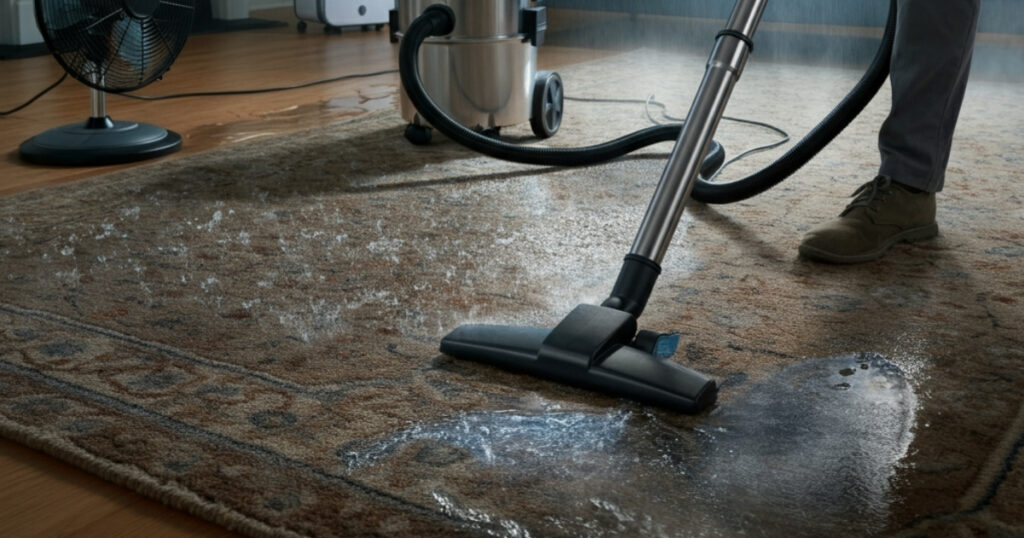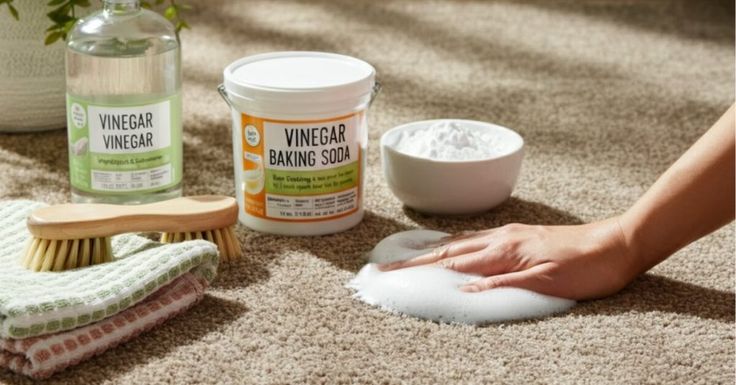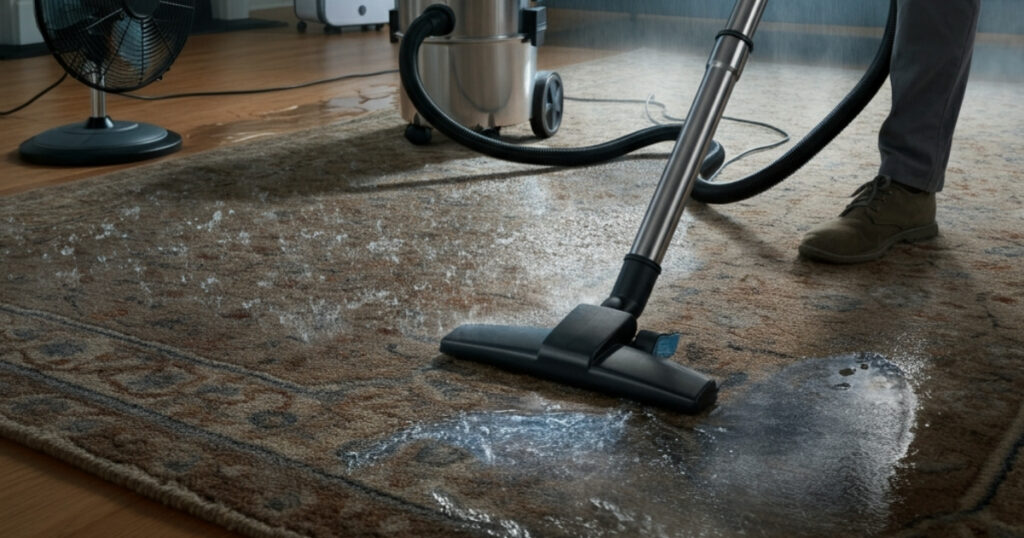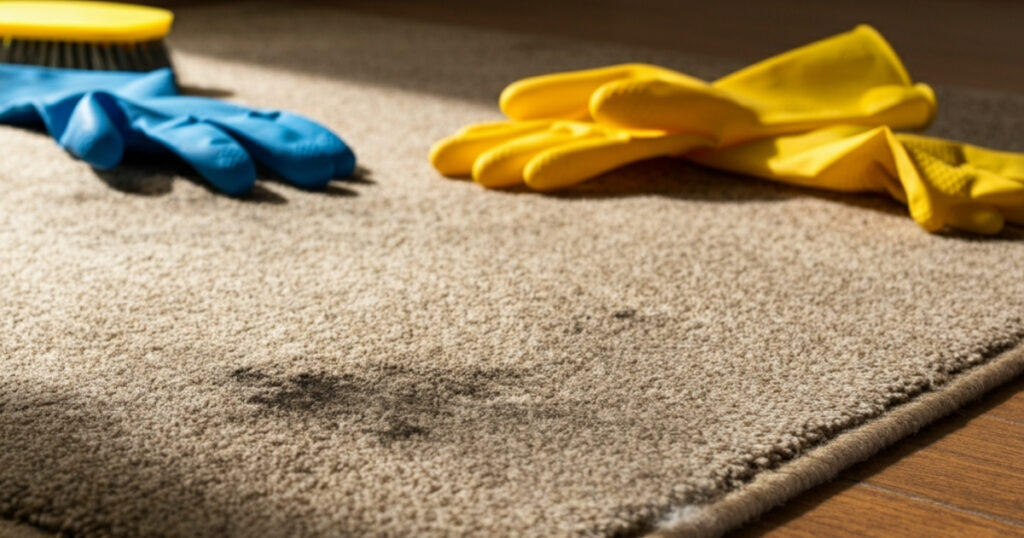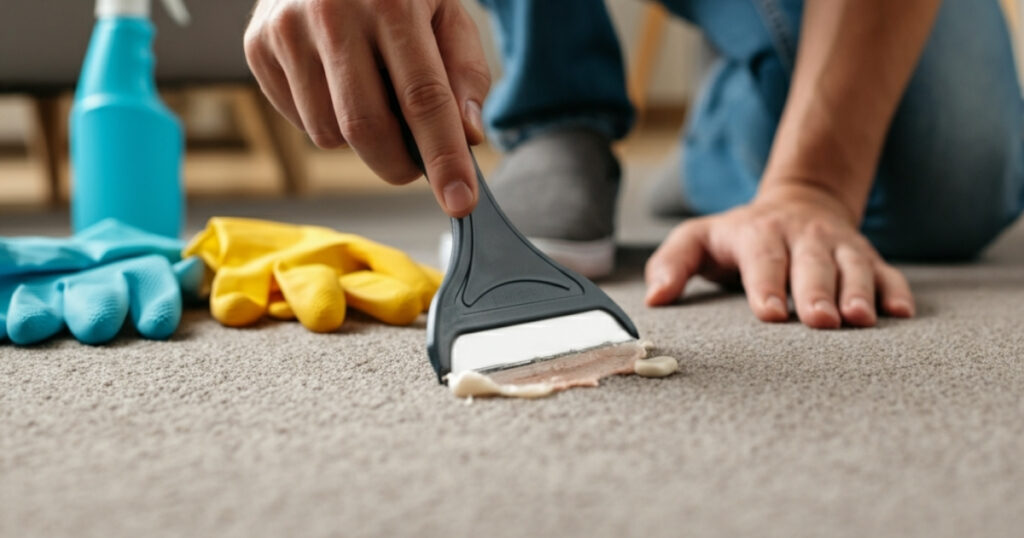As an Amazon Associate, I earn from qualifying purchases.
When flood water invades your home, your carpets often bear the brunt of the damage. Learning how to dry carpet from flood situations properly can mean the difference between salvaging your flooring and facing costly replacements. Water-soaked carpets pose serious risks including mold growth, structural damage, and health hazards if not addressed within 24-48 hours.
The key to successful carpet drying lies in acting fast and following the right steps. Whether you’re dealing with clean water from a burst pipe or contaminated flood water, this guide will walk you through the complete process of drying your carpets safely and effectively. You’ll discover professional techniques that can save thousands in replacement costs while protecting your family’s health.
Time is critical when water damage occurs. Every hour you wait increases the likelihood of permanent damage and mold formation. However, with the right approach and tools, most flood-damaged carpets can be restored to their original condition.
Contents Overview
Assess the Flood Damage Before You Start
Before attempting any drying process, you need to evaluate the extent of water damage to your carpet. This assessment determines whether the carpet can be saved and which drying method will be most effective.
Start by identifying the water source. Clean water from supply lines is easiest to work with, while gray water from appliances or black water from sewage requires professional intervention. If you’re dealing with contaminated water, contact a restoration professional immediately rather than attempting DIY cleanup.
Check how long the carpet has been wet. Carpets soaked for more than 48 hours in warm conditions almost always develop mold and may need replacement. Additionally, examine the carpet padding underneath, which typically requires removal and replacement after flood damage since it’s nearly impossible to dry thoroughly.
Measure the affected area to determine if you can handle the project yourself. Small areas under 10 square feet are manageable for most homeowners, but larger flood zones often require professional equipment and expertise.
Safety First: Preparing for Carpet Drying
Safety must be your top priority when dealing with flood-damaged carpets. Turn off electricity to the affected area at the circuit breaker to prevent electrocution. Never use electrical equipment in standing water or on wet floors.
Wear protective gear including rubber boots, gloves, and eye protection. If the water source is questionable, add a respirator to prevent inhaling harmful bacteria or mold spores. Keep children and pets away from the work area until drying is complete.
Remove all furniture and belongings from the flooded area. Place wooden furniture legs on aluminum foil or plastic blocks to prevent further water damage. This clearing process also allows better air circulation around the carpet during drying.
Document the damage with photos for insurance purposes before beginning cleanup. Most insurance policies cover sudden water damage, but you’ll need proof of the initial condition and your mitigation efforts.
Extract Standing Water Immediately
The first step in how to dry carpet from flood damage is removing as much standing water as possible. The faster you extract water, the better your chances of saving the carpet and preventing mold growth.
Start with a wet vacuum designed for water extraction. Regular household vacuums can be damaged by water and pose electrical hazards. If you don’t own a water extraction vacuum, rent one from a hardware store or hire a professional restoration company.
Work systematically across the carpet, making slow, overlapping passes. The vacuum should pick up water with a slurping sound. If you’re not hearing this, the vacuum may be full or clogged. Empty the tank frequently to maintain suction power.
For large areas, consider renting a truck-mounted extraction unit. These powerful machines can remove significantly more water than portable units, reducing drying time from days to hours. Professional restoration companies use these systems because of their superior extraction capabilities.
After vacuuming, press down on the carpet with clean towels to absorb remaining moisture. Replace towels as they become saturated. This manual absorption helps remove water that vacuum extraction might miss.
Remove Carpet Padding When Necessary
Carpet padding absorbs water like a sponge and rarely dries completely, making it a breeding ground for mold and bacteria. In most flood situations, you’ll need to remove and replace the padding even if you can save the carpet itself.
Pull back the carpet carefully from one corner. Use a utility knife to cut the padding into manageable sections for removal. Wet padding is heavy, so work in small sections to avoid injury.
Inspect the subfloor once padding is removed. If you find signs of water damage, warping, or mold growth on the subfloor, address these issues before installing new padding. Sometimes subflooring may need replacement or professional treatment.
Take measurements of the removed padding so you can purchase exact replacements. Most carpet padding comes in standard widths, but you’ll need to know the thickness and density to match your original installation.
Set Up Proper Air Circulation
Effective air circulation is crucial for drying carpet after flood damage. Without proper airflow, moisture remains trapped in carpet fibers and promotes mold growth.
Position multiple fans around the affected area to create cross-ventilation. Point fans directly at the carpet surface from different angles. Box fans work well for large areas, while smaller oscillating fans help with targeted drying.
Open all windows and doors if outdoor conditions permit. Low humidity days with temperatures between 70-80°F provide ideal drying conditions. However, if outdoor humidity is high, rely more on dehumidifiers and indoor air circulation.
Use box fans to exhaust humid air outside while drawing dry air in from other areas of your home. This creates a continuous air exchange that speeds the drying process significantly.
Consider renting commercial-grade air movers if you’re dealing with extensive flood damage. These powerful fans move much more air than household fans and can reduce drying time by half.
Deploy Dehumidifiers Strategically
Dehumidifiers are essential tools for removing moisture from the air during carpet drying. As water evaporates from your carpet, dehumidifiers capture this moisture before it can settle back into other materials.
Place dehumidifiers in the center of the affected room for maximum efficiency. Large rooms may require multiple units. Position them away from walls and furniture to ensure proper air circulation around the intake and exhaust vents.
Choose the right size dehumidifier for your space. A 30-pint unit works for areas up to 1,500 square feet, while larger spaces need 50-70 pint units. Professional restoration companies often use commercial dehumidifiers that can remove 100+ pints per day.
Monitor humidity levels with a hygrometer. Your goal is to maintain indoor humidity between 30-50%. Higher levels slow drying and encourage mold growth, while extremely low humidity can damage wood floors and furniture.
Empty dehumidifier tanks regularly or set up continuous drainage if your unit has this feature. Full tanks stop the dehumidification process and can overflow, adding more water to your problem.
Use Professional Drying Equipment When Needed
Sometimes household equipment isn’t sufficient for effective carpet drying after flood damage. Professional restoration equipment can dramatically improve results and prevent secondary damage.
Truck-mounted extraction units remove 10-20 times more water than portable units. These systems use powerful pumps and heated air to extract moisture that standard vacuums can’t reach. The investment in professional extraction often pays for itself by saving carpet replacement costs.
Commercial air movers create focused, high-velocity airflow that penetrates carpet fibers more effectively than household fans. These units are designed to run continuously for days without overheating.
Injectidry systems work beneath the carpet to dry the subfloor and tack strips simultaneously. This equipment prevents structural damage and eliminates moisture pockets that could cause future problems.
LGR (Low Grain Refrigerant) dehumidifiers are more efficient than conventional units in removing moisture from materials. They work effectively even in cooler conditions when standard dehumidifiers lose efficiency.
Monitor the Drying Process Daily
Successful carpet drying requires consistent monitoring and adjustment of your equipment setup. Check your progress daily to ensure the process is working effectively and catch any developing problems early.
Test carpet moisture levels with a moisture meter if available. These tools provide objective measurements rather than relying on touch alone. Carpet should reach moisture levels below 20% to prevent mold growth.
Look for signs of mold development, which can appear as dark spots, unusual odors, or fuzzy growth on carpet surfaces. If you notice any mold signs, increase air circulation and consider antimicrobial treatments.
Adjust fan positions as needed to target areas that aren’t drying as quickly. Low spots where water pools often need extra attention with focused airflow.
Document your progress with photos and notes. This information helps if you need to file insurance claims or consult with professionals about additional treatments.
Sanitize and Treat for Mold Prevention
Even after your carpet appears dry, treating for bacteria and preventing mold growth is essential, especially when learning how to dry carpet from flood water that may have been contaminated.
Apply antimicrobial treatments designed specifically for carpets. These products kill bacteria and mold spores that may have contaminated the fibers during flooding. Follow manufacturer instructions carefully for safe application.
Steam clean the carpet once it’s completely dry. Use hot water extraction with antimicrobial cleaning solutions to remove any remaining contaminants. This deep cleaning also helps restore the carpet’s appearance and texture.
Consider professional-grade treatments like enzyme cleaners that break down organic materials that bacteria and mold feed on. These treatments provide longer-lasting protection than surface antimicrobials alone.
Test a small, hidden area before applying any treatments to the entire carpet. Some chemicals can cause discoloration or damage to certain carpet materials.
Know When to Call Professionals
While many homeowners can successfully dry carpet from flood damage, some situations require professional intervention. Recognizing when you need help can save time, money, and protect your health.
Call professionals immediately if you’re dealing with category 3 water (sewage or flood water with high contamination levels). This water contains dangerous bacteria and chemicals that require specialized handling and disposal.
Large affected areas over 100 square feet typically need professional equipment and expertise. The logistics of drying extensive carpet areas often overwhelm household resources and equipment.
If mold appears during the drying process, stop your efforts and contact a certified mold remediation specialist. Disturbing established mold colonies can spread spores throughout your home and create health hazards.
Valuable or antique carpets should be handled by restoration specialists who have experience with delicate materials. DIY efforts on expensive carpets can result in permanent damage that exceeds the cost of professional restoration.
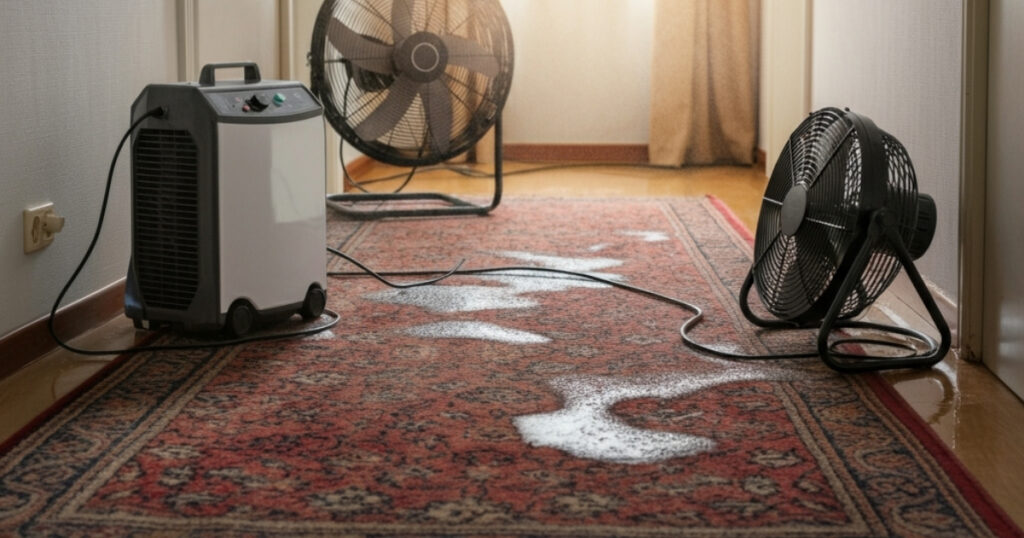
Frequently Asked Questions
1. How long does it take to dry carpet from flood damage?
Typically 2-5 days with proper equipment and conditions. Thick carpets and humid conditions extend drying time significantly.
2. Can I save carpet padding after flooding?
No, carpet padding should almost always be replaced after flood damage. It absorbs too much water and rarely dries completely.
3. What temperature should I maintain for carpet drying?
Keep temperatures between 70-80°F for optimal drying conditions. Higher temperatures can damage carpet fibers.
4. Should I use bleach to clean flood-damaged carpet?
No, bleach can discolor and damage most carpets. Use carpet-specific antimicrobial treatments instead.
5. How do I know if my carpet is completely dry?
Use a moisture meter to confirm readings below 20%, or press a paper towel firmly against the carpet for 30 seconds to check for moisture transfer.
6. Can I walk on carpet while it’s drying?
Minimize foot traffic on drying carpet to prevent recontamination and allow better air circulation around the fibers.
7. What if my carpet still smells after drying?
Persistent odors usually indicate incomplete drying or bacterial growth. Consider professional cleaning or antimicrobial treatments.
Take Action to Save Your Carpets Today
Learning how to dry carpet from flood damage properly can save thousands in replacement costs while protecting your home’s health and safety. The key is acting quickly, using the right equipment, and following systematic drying procedures that address both visible water and hidden moisture.
Remember that time is your most critical factor. Every hour you delay increases the risk of permanent damage and mold growth. If you’re dealing with extensive damage or contaminated water, don’t hesitate to call professionals who have the equipment and expertise to handle complex situations safely.
Start your carpet recovery process today by assessing the damage, gathering necessary equipment, and following the step-by-step procedures outlined in this guide. With prompt action and proper techniques, most flood-damaged carpets can be restored to their original condition, saving both money and preserving your home’s comfort.
As an Amazon Associate, I earn from qualifying purchases.

